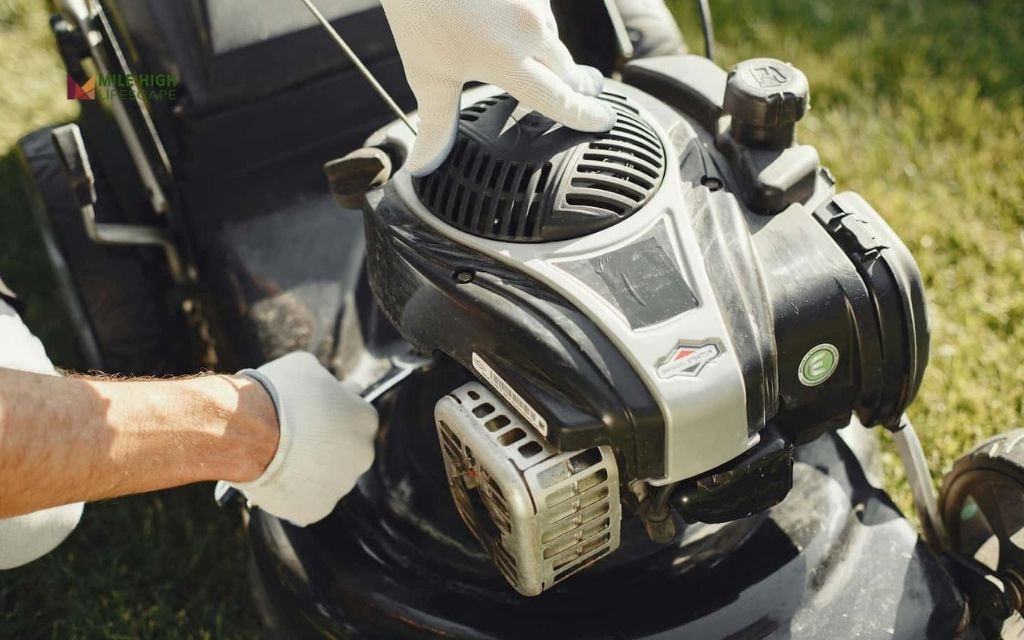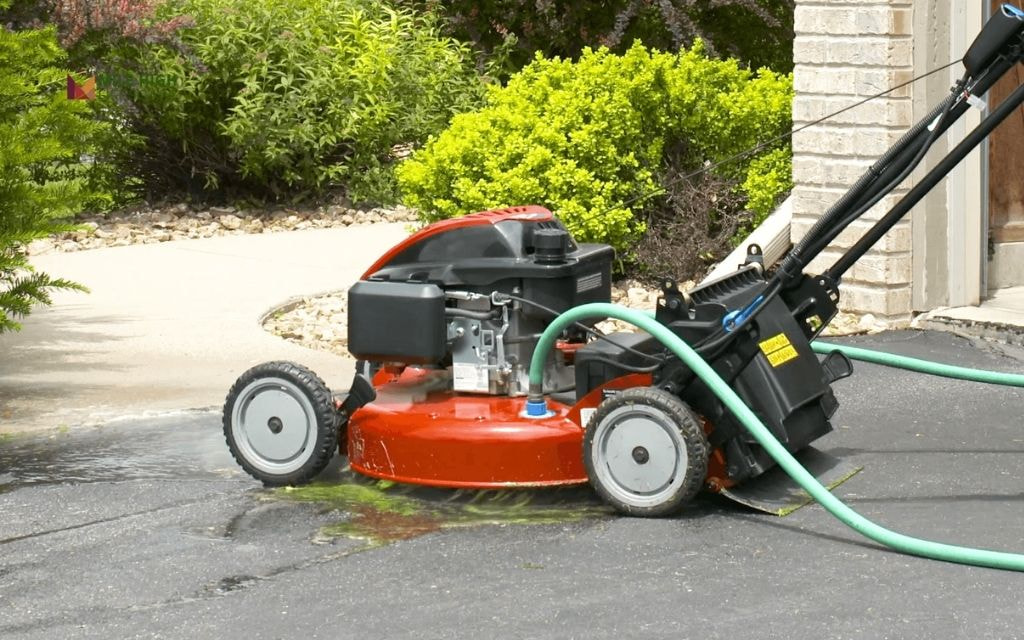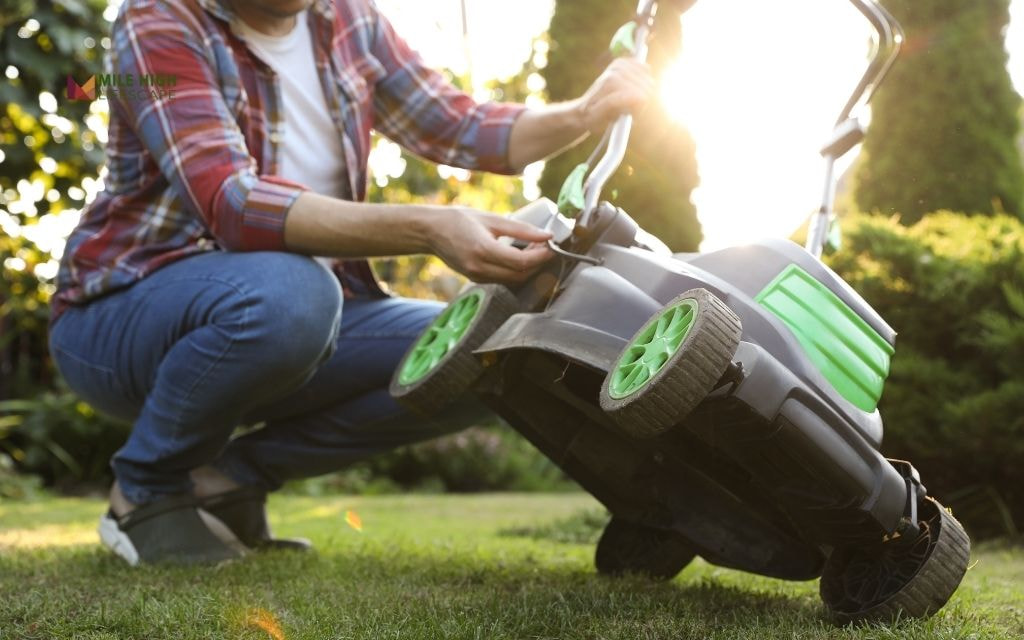How to winterize a lawn mower effectively? To protect your mower from Denver’s harsh winter conditions, you must safeguard the engine and fuel system against freezing temperatures and moisture while preparing the machine for reliable spring operation.
Denver’s extreme temperature swings create unique challenges for lawn equipment. When homeowners skip winterization, they face fuel system clogs, engine corrosion, and frustrating hard starts come spring. These problems cost hundreds in repairs and replacement parts.
In this comprehensive guide, we’ll walk Denver homeowners through a professional-level winterization process, customized for our region’s specific climate demands.

How to winterize a lawn mower: complete step-by-step process
Step 1: Drain or stabilize the fuel system
Use fuel stabilizer for mowers you’ll start occasionally during winter. Drain completely if storing for the entire season without use.
Process:
- Add stabilizer to a nearly full tank
- Run the engine for 10 minutes to circulate treated fuel
- For complete drainage, run the engine until it stops naturally
Step 2: Change the oil
Removing contaminated oil prevents sludge buildup during storage. Old oil contains moisture and combustion byproducts that corrode internal components.
Process:
- Warm the engine briefly for easier oil flow
- Position a drain pan under the drain plug
- Remove the drain plug with appropriate wrench
- Allow complete drainage (15-20 minutes)
- Replace drain plug and refill with manufacturer-specified oil
- Dispose of used oil at local auto parts stores or recycling centers
Step 3: Remove, clean, or replace air filter
Check whether your mower uses foam, paper, or dual-element filters. Each requires different maintenance approaches. Replace filters older than one season. Clean foam filters can be reused; paper filters should always be replaced when dirty.
Cleaning process:
- Remove filter housing cover
- Inspect filter condition
- Wash foam filters in warm, soapy water
- Allow complete drying before reinstallation
- Replace paper filters if discolored or clogged

Step 4: Clean the mower thoroughly
Focus on the undercarriage, blade assembly, and discharge chute. Grass clippings and debris retain moisture, promoting rust formation.
Cleaning process:
- Scrape off dried grass and debris
- Wash with garden hose (avoid electrical components)
- Dry thoroughly with compressed air or cloth
- Apply light oil coating to exposed metal
Step 5: Disconnect battery (for riding mowers)
Store batteries indoors in dry locations to preserve charge cycles. Cold temperatures reduce battery capacity and can cause permanent damage.
Storage options:
- Remove battery completely for indoor storage
- Use a trickle charger for garage storage
- Check electrolyte levels before storage
- Clean terminals to prevent corrosion
Step 6: Add fogging oil (optional but recommended)
Fogging oil prevents internal corrosion in carbureted engines during extended storage. This step is particularly valuable for mowers stored in unheated spaces.
Application method:
- Remove spark plug
- Spray fogging oil into cylinder
- Pull starter cord several times to distribute oil
- Reinstall spark plug
Step 7: Store it properly
Choose covered, dry, pest-resistant storage areas. Basements, garages, or sheds work well when properly prepared.
Storage setup:
- Elevate mower on wood blocks or rubber mats
- Use breathable fabric covers instead of plastic tarps
- Ensure adequate ventilation around stored equipment
- Keep away from water heaters and furnaces
Benefits of winterizing your lawn mower
- Extended equipment life: Proper winterization prevents component wear and reduces expensive repair needs. Well-maintained mowers last 15-20 years versus 8-10 years for neglected equipment.
- Superior spring performance: Winterized mowers start easily and run smoothly when warm weather returns. You avoid the frustration of multiple repair shop visits.
- Enhanced fuel efficiency: Clean fuel systems and fresh oil ensure optimal engine performance, reducing fuel consumption throughout the growing season.
- Significant cost savings: Preventive winterization costs $30-50 annually but prevents $200-500 repair bills. Early problem detection saves thousands over equipment lifetime.
- Rust and corrosion protection: Critical protection against Denver’s moisture and temperature extremes. Proper storage prevents costly component replacement.
When should you winterize your lawn mower in Denver?
You should winterize your lawn mower after your final mowing but before Denver’s first major freeze. This typically occurs between mid-October and early November. Watch forecast patterns and winterize when nighttime temperatures consistently approach freezing. Don’t wait for the first snow warning.
When grass growth stops and leaves begin falling heavily, start your winterization process. Delaying risks sudden temperature drops that complicate preparation.

How to know if your lawn mower is ready for winter storage
Winterization checklist verification:
- Engine runs smoothly with fresh oil
- Fuel system contains stabilized gas or is completely drained
- Air filter is clean or newly replaced
- Mower exterior is clean and dry
- Battery is removed or properly charged
- Blade is sharp and free from damage
- All moving parts are lubricated
Test-start the mower after winterization to ensure proper operation. Address any unusual sounds or performance issues before storage.
When to call in a professional
Warning signs requiring professional attention:
- Engine runs roughly despite fresh fuel and oil
- Difficulty accessing fuel system components
- Visible rust or corrosion on critical parts
- Mower fails to start after completed winterization
- Unusual noises or vibrations during operation
Mile High Lifescape professional services: Our lawn care experienced technicians provide comprehensive winterization and seasonal tune-ups for both gas and electric mowers. We offer complete seasonal maintenance programs that prepare your equipment for spring operation and maintain peak performance year-round.
With over 20 years serving the Denver Metro area, Mile High Lifescape understands the unique challenges our climate presents. We provide reliable, professional equipment maintenance that extends mower life and ensures dependable operation.
Conclusion
Proper lawn mower winterization protects your investment and ensures reliable spring operation. Following these Denver-specific steps prevents costly repairs and extends equipment life significantly.
How to winterize a lawn mower process requires basic tools and 2-3 hours of time but saves hundreds in potential repair costs. Local climate considerations make professional winterization even more valuable for Denver homeowners.
Contact Mile High Lifescape today for a free consultation on professional winterization services or spring preparation packages. Our expert team makes equipment maintenance simple and reliable.
Frequently asked questions (FAQs)
Should I winterize the other tools I use in mowing?
Yes, winterize all gas-powered lawn equipment including trimmers, edgers, and leaf blowers. Follow similar fuel stabilization and oil change procedures. Store batteries indoors and clean all equipment thoroughly before storage.
Where should I put my lawn mower during winter?
Store your mower in a dry, covered area like a garage, basement, or shed. Avoid outdoor storage under tarps, which trap moisture. Elevate the mower on blocks and ensure proper ventilation around the storage area.
Do lawn mowers need to be winterized?
Yes, lawn mowers require winterization in climates with freezing temperatures. Proper winterization prevents fuel system damage, engine corrosion, and starting problems. The process extends equipment life and ensures reliable spring operation.
Is it okay to leave gas in a lawn mower over winter?
Only with proper fuel stabilization. Untreated gas degrades over time, forming gum deposits that clog fuel systems. Use quality fuel stabilizer or drain the tank completely for extended storage periods.
How to overwinter a lawnmower?
Complete fuel system maintenance, change oil, clean or replace air filter, thoroughly clean the mower, remove the battery if applicable, and store in a dry, covered location. Proper preparation prevents damage and ensures spring readiness.
